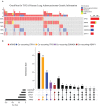New Horizons in KRAS-Mutant Lung Cancer: Dawn After Darkness
- PMID: 31612108
- PMCID: PMC6773824
- DOI: 10.3389/fonc.2019.00953
New Horizons in KRAS-Mutant Lung Cancer: Dawn After Darkness
Abstract
In non-small cell lung cancer (NSCLC), the most frequent oncogenic mutation in western countries is KRAS, for which, however, there remains no clinically approved targeted therapies. Recent progress on high biological heterogeneity including diverse KRAS point mutations, varying dependence on mutant KRAS, wide spectrum of other co-occurring genetic alterations, as well as distinct cellular status across the epithelial-to-mesenchymal transition (EMT), has not only deepened our understanding about the pathobiology of KRAS-mutant NSCLC but also brought about unprecedented new hopes for precision treatment of patients. In this review, we provide an update on the most recent advances in KRAS-mutant lung cancer, with a focus on mechanistic insights into tumor heterogeneity, the potential clinic implications and new therapies on horizons tailored for KRAS-mutant lung cancer.
Keywords: KRAS; heterogeneity; immunotherapy; lung cancer; mitogen-activated protein kinases; targeted therapy.
Copyright © 2019 Yang, Liang, Schmid and Peng.
Figures



References
Publication types
LinkOut - more resources
Full Text Sources
Other Literature Sources
Miscellaneous

